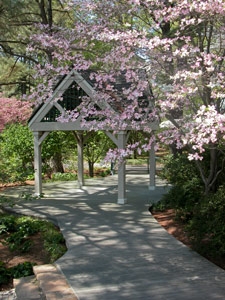
Created with excavated soil from the canal, this peaceful spot offers visitors a view of the waterway and surrounding gardens from its two-tier deck and gazebo. Relax under the shade of a mature oak tree overlooking broad sweeps of plants selected especially for their color and texture. Drought tolerant plants grow near the top of the hill while moisture loving plants thrive at the bottom.
PLANTS TO LOOK FOR:
- Spring: Epimedium, Saucer Magnolia
- Summer: Bear’s Breeches, Butterfly Bush, Glossy Abelia, Summersweet
- Fall: Bluebeard, Linden Viburnum, Salvia, Stonecrop
- Winter: Japanese Holly Fern, Wintersweet, Witchhazel
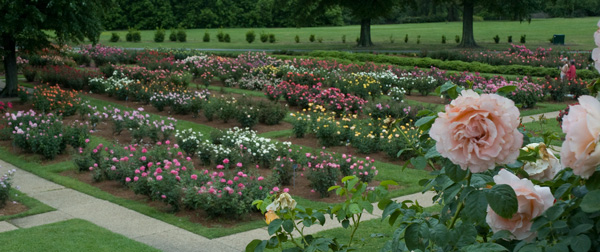
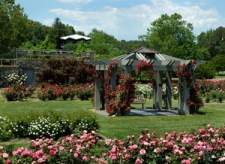 The rose garden was dedicated in 1976 as a bicentennial tribute to the nation. This garden has been accredited as one of 130 All-American Rose Selections Display Gardens. Over 3,000 rose plants representing more than 300 varieties grow in this garden. At the height of bloom, mid-May through October, more than 250,000 rose blooms may be seen. This garden has an accessible terrace overlooking seating areas, fountains, and picturesque garden surroundings.
The rose garden was dedicated in 1976 as a bicentennial tribute to the nation. This garden has been accredited as one of 130 All-American Rose Selections Display Gardens. Over 3,000 rose plants representing more than 300 varieties grow in this garden. At the height of bloom, mid-May through October, more than 250,000 rose blooms may be seen. This garden has an accessible terrace overlooking seating areas, fountains, and picturesque garden surroundings.
Roses are one of the Garden’s primary collections. Learn more about the collection.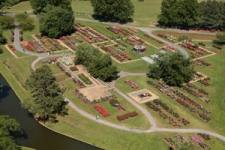
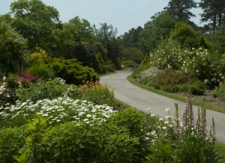 One of the Garden’s main pathways leads through the Border Garden. A variety of flowering shrubs including a row of white-flowering ‘Diana’ hibiscus provide a backdrop to mixed plantings of perennials and annuals. Inspired by the soft and romantic gardens of renowned landscape designers Beatrix Farrand and Gertrude Jekyll, this garden is filled with flowers in pastel hues. Perennials like gayfeather, peonies, roses, verbena and phlox tumble together reminiscent of the Impressionistic style of painting.
One of the Garden’s main pathways leads through the Border Garden. A variety of flowering shrubs including a row of white-flowering ‘Diana’ hibiscus provide a backdrop to mixed plantings of perennials and annuals. Inspired by the soft and romantic gardens of renowned landscape designers Beatrix Farrand and Gertrude Jekyll, this garden is filled with flowers in pastel hues. Perennials like gayfeather, peonies, roses, verbena and phlox tumble together reminiscent of the Impressionistic style of painting.
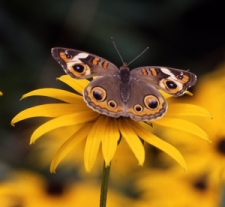 The 2-acre Bristow Butterfly Garden provides a habitat to attract and support butterflies and moths during all stages of their life cycle. Within the garden you will find a swallowtail and monarch nursery, nectar garden, moonlight garden and butterfly bush collection. Our Butterfly House opens seasonally and provides an up close experience with a variety of butterflies.
The 2-acre Bristow Butterfly Garden provides a habitat to attract and support butterflies and moths during all stages of their life cycle. Within the garden you will find a swallowtail and monarch nursery, nectar garden, moonlight garden and butterfly bush collection. Our Butterfly House opens seasonally and provides an up close experience with a variety of butterflies.
Visit our Butterfly House page for more detailed information.
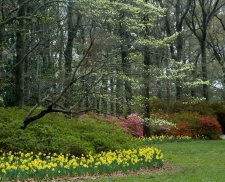 This garden is located on a peninsula of land at the north end of Norfolk Botanical Garden. The mature overstory of oak, hickory, and pine creates a wonderful secluded retreat for walkers, birdwatchers and nature lovers. The treasures of this garden can be enjoyed by strolling along on a paved trail or a woodland trail, which also offers scenic views of Lake Whitehurst.
This garden is located on a peninsula of land at the north end of Norfolk Botanical Garden. The mature overstory of oak, hickory, and pine creates a wonderful secluded retreat for walkers, birdwatchers and nature lovers. The treasures of this garden can be enjoyed by strolling along on a paved trail or a woodland trail, which also offers scenic views of Lake Whitehurst.
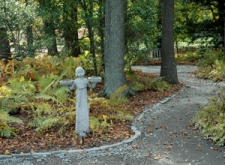 A cobblestone lined path leads visitors into a sanctuary of ferns and other shade loving plants. A forest of red maples, sweetgums, hollies and pines provide the shady canopy. Two cobblestone patios with benches offer quiet and secluded rest stops in the heart of the Garden.
A cobblestone lined path leads visitors into a sanctuary of ferns and other shade loving plants. A forest of red maples, sweetgums, hollies and pines provide the shady canopy. Two cobblestone patios with benches offer quiet and secluded rest stops in the heart of the Garden.
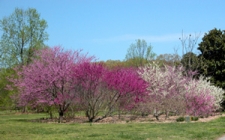 The Flowering Arboretum fills 17.5 acres in the center of the Botanical Garden. In 1982, a section of Crapemyrtle trees was added to the original acreage. Today the arboretum contains 336 different flowering trees. Because it displays a wide variety of fragrant and colorful flowering trees, homeowners and horticultural students look to the Arboretum as an excellent reference.
The Flowering Arboretum fills 17.5 acres in the center of the Botanical Garden. In 1982, a section of Crapemyrtle trees was added to the original acreage. Today the arboretum contains 336 different flowering trees. Because it displays a wide variety of fragrant and colorful flowering trees, homeowners and horticultural students look to the Arboretum as an excellent reference.
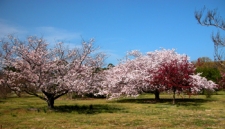 In 2015, the Flowering Arboretum will take on a new look that will benefit the environment and wildlife. Visitors will notice areas that are not mowed. As the grass grows mowed pathways will be created for increased visitation in the Arboretum. Visitors will expect to see wildflower meadows with increased activity for pollinators and wildlife.
In 2015, the Flowering Arboretum will take on a new look that will benefit the environment and wildlife. Visitors will notice areas that are not mowed. As the grass grows mowed pathways will be created for increased visitation in the Arboretum. Visitors will expect to see wildflower meadows with increased activity for pollinators and wildlife.
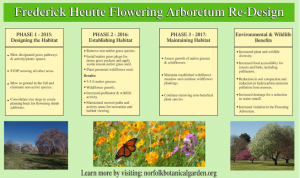
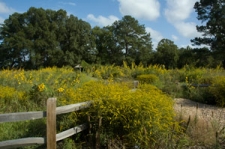 This meadow features a mixture of more than 50 species of wildflowers and 10 species of grasses. The area is an outdoor classroom where one can observe wildflowers and the birds and insects they attract. It demonstrates an alternative to traditional high maintenance urban landscaping. Most importantly, the flowers and grasses present a constantly changing vista of natural beauty for those who stroll along its pathways or relax near the flowing fountain in the shade of the gazebo.
This meadow features a mixture of more than 50 species of wildflowers and 10 species of grasses. The area is an outdoor classroom where one can observe wildflowers and the birds and insects they attract. It demonstrates an alternative to traditional high maintenance urban landscaping. Most importantly, the flowers and grasses present a constantly changing vista of natural beauty for those who stroll along its pathways or relax near the flowing fountain in the shade of the gazebo.
Perry E. Morgan donated money for the establishment and maintenance of The Bunny Morgan Memorial Wildflower Meadow, now the Four Seasons Garden, in honor of his late wife, who had long been a wildflower enthusiast.
Plants to look for:
- Spring: Five Spot, Poppies, Bachelor’s Button
- Summer: Tickseed, Gayfeather, Sunflower
- Fall: Native Grasses
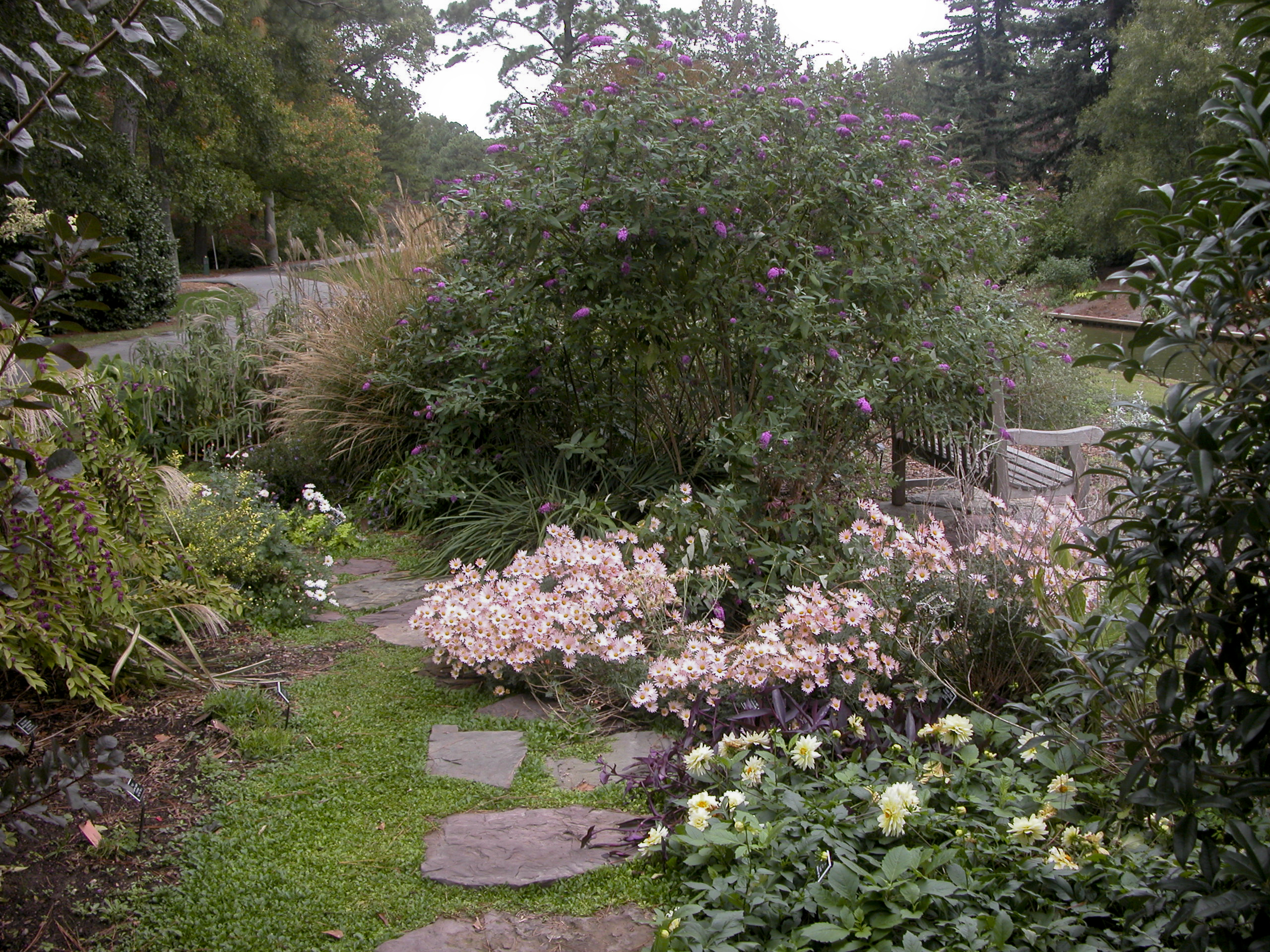 The Matson Perennial Garden is located next to Renaissance Court and the Border Garden. The Garden was created in honor of Pat and Kay Matson, who were known in the Hampton Roads community for bringing new perennials into the area. The Matson Perennial Garden is about a quarter of an acre in size and is filled with new cultivars of the same plants that the Matsons first introduced in the Hampton Roads area and some of the original plants that they donated to Norfolk Botanical Garden. This garden includes both shady and sunny spots, a stream, a dry stack wall and stone pathways. Sweeps of perennials border the canal and smaller plants are tucked into niches along the paved road.
The Matson Perennial Garden is located next to Renaissance Court and the Border Garden. The Garden was created in honor of Pat and Kay Matson, who were known in the Hampton Roads community for bringing new perennials into the area. The Matson Perennial Garden is about a quarter of an acre in size and is filled with new cultivars of the same plants that the Matsons first introduced in the Hampton Roads area and some of the original plants that they donated to Norfolk Botanical Garden. This garden includes both shady and sunny spots, a stream, a dry stack wall and stone pathways. Sweeps of perennials border the canal and smaller plants are tucked into niches along the paved road.
PLANTS TO LOOK FOR:
- Spring: Columbine, Foam-flower, Geranium
- Summer: Ginger Lily, Pinapple Lily, Russian Sage, Taro
- Fall: Chrysanthemum, Coneflower, Joe-Pye Weed, Stonecrop
- Winter: Alexandrian Laurel, Maiden Grass, Rose Acacia
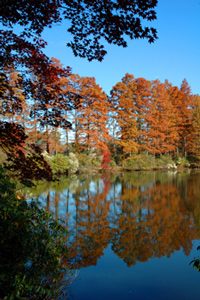 This area is the oldest part of the garden, where WPA workers began clearing for azalea plantings in 1939. These original azaleas still put on a show stopping display every spring. In 2008, the 70th anniversary of Norfolk Botanical Garden, a memorial garden was created to honor the legacy of the WPA workers.
This area is the oldest part of the garden, where WPA workers began clearing for azalea plantings in 1939. These original azaleas still put on a show stopping display every spring. In 2008, the 70th anniversary of Norfolk Botanical Garden, a memorial garden was created to honor the legacy of the WPA workers.
This garden is best explored on foot. There are several well manicured woodland trails, as well as a paved road, that lead visitors through our vast collections of azaleas and mountain laurels. Mirror Lake is also home to several species of native orchids, ferns, and other unique native woodland plants.
This is a prime garden for viewing wildlife, especially birds. Be on the lookout for wood ducks, owls, hawks, and warblers.
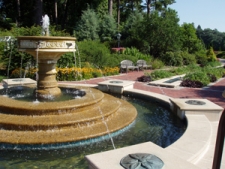 This spectacular 1-acre garden honors Sarah Lee Baker, who funded many features throughout the garden with her husband Isaac “Junie” Baker. Moving water in the central limestone fountain and terraced canals creates a soothing and cooling effect. The formal circular garden is divided into wedges that overflow with more than 200 different varieties of perennials of all shapes and sizes.
This spectacular 1-acre garden honors Sarah Lee Baker, who funded many features throughout the garden with her husband Isaac “Junie” Baker. Moving water in the central limestone fountain and terraced canals creates a soothing and cooling effect. The formal circular garden is divided into wedges that overflow with more than 200 different varieties of perennials of all shapes and sizes.
PLANTS TO LOOK FOR:
- Spring: Bluestar, Fothergilla, False Indigo, Iris
- Summer: Canna Lily, Rose Mallow, Speedwell, Whirling Butterflies
- Fall: Confederate Rose, Joe-Pye Weed, Salvia, Stonecrop, Ornamental Grasses
- Winter: Kerria, Paperbush, Yaupon
This small woodland garden was once used as an outdoor classroom for horticultural study. Because of this, there is a diverse array of plant material. Lirope lines the paths that guide the visitor through our collection of shade loving perennials, shrubs, and trees. This area features a small collection of Encore hybrid azaleas.
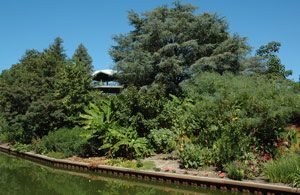 Descend the steps below NATO Overlook and enter a different world. Tropical and subtropical plants that thrive outdoors in Hampton Roads line the bank of the canal. A warm microclimate created by the water and protected hillside help these plants survive a winter here but not elsewhere in Virginia since Norfolk is at the northern edge of USDA zone 8.
Descend the steps below NATO Overlook and enter a different world. Tropical and subtropical plants that thrive outdoors in Hampton Roads line the bank of the canal. A warm microclimate created by the water and protected hillside help these plants survive a winter here but not elsewhere in Virginia since Norfolk is at the northern edge of USDA zone 8.
PLANTS TO LOOK FOR:
- Spring: Bird of Paradise
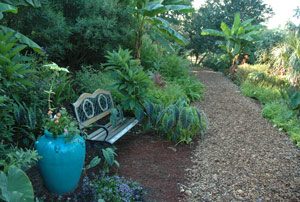 Summer: Voodoo Lily, Willow-leaved Jessamine, Cigar Flower, Indigo
Summer: Voodoo Lily, Willow-leaved Jessamine, Cigar Flower, Indigo- Fall: Bottlebrush, Winged Crown Beard, Hibiscus, Lion‘s Ear
- Winter: Daphniphyllum, Dioon, Gum tree, Coontie
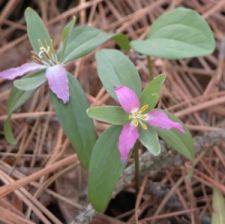 This garden invites you to explore four historic plant communities indigenous to the southeast coastal plain of VA. Included in this garden is the R.W. Cross Nature Trail, which features a boardwalk that winds through a bottomland hardwood forest, a bald cypress /water tupelo swamp, an Atlantic white cedar swamp, and a longleaf pine stand. Each community features an interpretive sign highlighting the featured plants and their importance to people and wildlife. The boardwalk also offers beautiful views of Lake Whitehurst and the wildlife that frequent its shores.
This garden invites you to explore four historic plant communities indigenous to the southeast coastal plain of VA. Included in this garden is the R.W. Cross Nature Trail, which features a boardwalk that winds through a bottomland hardwood forest, a bald cypress /water tupelo swamp, an Atlantic white cedar swamp, and a longleaf pine stand. Each community features an interpretive sign highlighting the featured plants and their importance to people and wildlife. The boardwalk also offers beautiful views of Lake Whitehurst and the wildlife that frequent its shores.
This garden also features native plants rescued from the wild due to the imminent destruction of their habitat.

